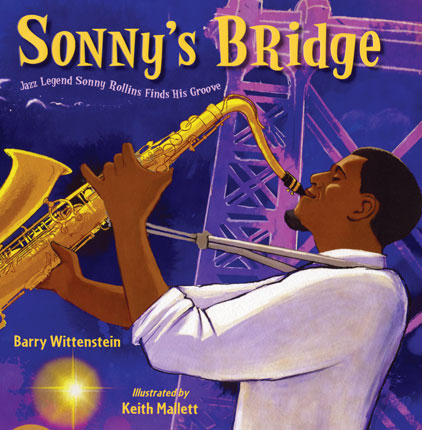| Sonny's bridge : jazz legend Sonny Rollins finds his groove Author: Wittenstein, Barry | ||
| Price: $6.50 | ||
Summary:
A picture book biography chronicles the legendary jazz saxophonist Sonny Rollin's search for inspiration on the Williamsburg Bridge in 1959.
| Illustrator: | Mallett, Keith |
Reviews:
Kirkus Reviews (+) (03/15/19)
School Library Journal (+) (05/01/19)
Booklist (05/01/19)
Full Text Reviews:
Booklist - 05/01/2019 Walter Theodore “Sonny” Rollins was born during the Jazz Age in the cradle of the Harlem Renaissance. After WWII, jazz slowly morphed into bebop, and Sonny was in the middle of it. Overwhelmed by early fame, the young saxophonist decided to take a break from the limelight—until the siren song called again, and he began practicing on the Williamsburg Bridge, away from complaining neighbors. The text is divided into “sets,” framing the narrative within larger historical moments, and Wittenstein presents the story in jaunty, lyrical phrasings. He also works in the titles of famous standards like “Stompin’ at the Savoy” and “Take the ‘A’ Train.” Mallett’s palette alternates between royal purples and sandy browns, with the digital art seeming to glow during Sonny’s highs and dim during his lows. The back matter details some of his heavier moments, including issues with substance abuse, and it mentions a current-day project to rename the Williamsburg Bridge after Rollins. A good choice for collections in need of biographies focused on music or lesser-known African American musicians. - Copyright 2019 Booklist.
School Library Journal - 05/01/2019 Gr 1–4—The life of jazz legend Sonny Rollins pulses with the rousing spontaneity of his music in Wittenstein's free verse biography. Readers witness Rollins's career as an acclaimed musician followed by his explosive success and the subsequent reincarnations of his art. When Rollins feels like his career is one out-of-control improvisation, he ducks out of the limelight, devoting days and nights to playing his sax on the Williamsburg Bridge. On that bridge, he does some soul-searching; after two years, he returns to the spotlight as a more confident, grounded musician. Wittenstein's verse replicates the swift tempo of bebop, interspersing rhyme and combining informal vernacular with a sense of extemporization in the rhythm. Some words, such as "per-co-lat-ing," are punctuated at every syllable, each striking like a staccato note. Others are emphasized in all caps and are onomatopoeic ("BOOM BOP BEBOP!"). Mallett's smooth, bold illustrations are rendered in dusky purples, moody blues, and earth tones: colors suggesting notes of jazz swirling through a thick night sky. An author's note, liner notes to Rollins's seminal album, The Bridge, a time line, and additional content provide an opportunity for further exploration. VERDICT Pair with Rollins's music to introduce children to this legendary musician and to the rhythmic exuberance of jazz.–Melissa Williams, Berwick Academy, ME - Copyright 2019 Publishers Weekly, Library Journal and/or School Library Journal used with permission.



